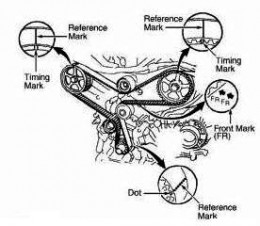Introduction
The Toyota 5SFE motor is a 4 cylinder 2.2 liter timing belt driven double overhead cam engine design. This motor is commonly found in the Camry, Celica, MR2 and RAV4 from 1990 to 2001. The engine is a Non-Interference type meaning damage to either the valves or pistons is unlikely to occur if the belt were to ever brake during vehicle operation. The outlined instructions can therefore be used on belts that have broken. Positioning the Camshaft Sprocket and the Crankshaft Pulley for Top-Dead-Center (TDC) alignment is all that is needed for broken belt replacement.
 Expect to spend approximately 3 hours for just a belt replacement. Replacement of the water pump (approximately 1/2 hour) and sprocket seals (approximately 1/2 or less per seal) can vary.
Expect to spend approximately 3 hours for just a belt replacement. Replacement of the water pump (approximately 1/2 hour) and sprocket seals (approximately 1/2 or less per seal) can vary.
The belt replacement interval for the 5SFE engine is either 60,000 or 90,000 miles based on the year of vehicle manufacture. Perhaps the introduction of Highly Saturated Nitrile (HSN) Timing Belts adopted for used on Toyota vehicles raised the service interval. Also the time since last replacement should be considered as well. Belt replacement every 6 to 7 years is recommended if under the mileage threshold.
It is recommended that the two Idler Pulleys (one for belt tension and the other as a belt guide) be replaced with every belt change. If the bearings in any of the pulleys were to lose its lubricating properties, the pulley can either wobble placing undue stress on the timing belt or potentially seize guaranteeing belt failure. Worn bearings can be noticed by a pitched grinding noise during engine warm up. When whatever grease remaining inside the bearing lubricates the bearings through engine heat, the noise will disappear. This can be considered a warning to have the belt and bearings replaced as soon as feasible.
Although many dealerships and private service stations recommend Water Pump replacement with the Timing Belt, based on personal experience, the AISIN Water Pumps in Toyotas are very durable. If the coolant has been changed per manufacturer’s recommended interval, and no hard mineral water used, the pump seals and bearings should last over 150,000 miles. This is based on personal experience with many 5SFE belt replacements jobs. However, the pump can be examined for wear and leakage after the Timing Belt Cover has been removed with the Timing Belt. Look for leakage from the weep hole, any chirping noise from the pump when the engine is running and any drag on the pulley when turned by hand after the timing belt has been removed.
On 5SFE engines with over 100,000 miles, there is a good possibility of oil seal wear for the Camshaft, Crankshaft and Oil Pump. The seals are inexpensive but can be time consuming to replace. If the leakage is very bad, oil will get on your Timing Belt which may cause pre-mature belt failure. Moreover, check the Side Engine Control Rod (commonly referred to as the Dog Bone) along with the front engine mount which dampens the the forward and backward flexing of the engine. The rubber vibration dampener has a tendency to dry rot and crack with age. A simple test is to ‘blip’ the engine with the transmission in gear while having your foot on the brakes. If the engine lifts up and settles back down, a new front mount may be in order. Replacement is simple and straightforward. Otherwise, the exhaust system’s flex pipe may eventually crack leading to expensive repairs.
The cost of the belt and components can vary. For Japanese OEM parts: Mitsuboshi Timing Belt, Koyo Pulleys and Aisin Water Pump. Shop and compare prices including shipping costs for the best deals. The belt manufacturers Gates and Dayco, OEM suppliers for Car companies like Honda, are very good and their belts can be had for approximately $15. A Timing Belt Component Kit (Belt, Idle Pulley & Tensioner Pulley) around $50. Water Pumps … around $30, Oil Seals … around $5 each. The parts that comprise a Timing Belt Component Kit for the 5SFE is interchangeable with the following Toyota vehicles:
CELICA (1999)
CELICA GT (1987 – 1998)
CELICA GTS (1990 – 1992)
CELICA GTS SPORT (1990 – 1993)
CELICA ST (1987 – 1989)
MR2 (1991 – 1995)
RAV4 (1996 – 2000)
SOLARA (1999 – 2001)

